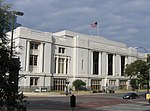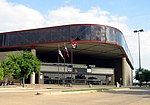On August 18, 1989, Luis Carlos Galán, a liberal presidential candidate for Colombia for the 1990-1994 period, was assassinated while greeting a crowd of supporters in the central square of the town of Soacha, near Bogotá. Galán was campaigning and stood on an improvised platform, along with his bodyguards Santiago Cuérvo Jiménez and Pedro Nel Angulo Bonilla, and Julio César Peñaloza Sánchez, a councilman from Soacha, when Galán, Peñaloza and Cuervo were shot dead by Jaime Eduardo Rueda Rocha and Henry Pérez, hitmen in the service of drug lord Gonzalo Rodríguez Gacha 'El Mexicano', a member of the Medellín Cartel, an organization also known as 'Los Extraditables', also led by drug lord Pablo Escobar, and allied with them the politician Alberto Santofimio Botero. Although the regional hospital of Soacha was nearby, Galán was taken by car to the hospital in the town of Bosa in Bogotá, a bit far away, but the hospital lacked the equipment to save him, Galán had to be transferred to the Kennedy Hospital, in the town of the same name in Bogotá, where he was declared dead at 11 pm that same day after medical efforts.
Rueda Rocha and Henry Pérez escaped to the Magdalena Medio region, while other accomplices fled to Melgar. Following the strong order of President Virgilio Barco to capture those responsible for the assassination, the police captured several people, who turned out to be innocent, and shortly after, following a tip-off, the perpetrators of the crime were captured. However, despite the capture of the perpetrators of the crime, the innocent people remained in prison for almost 5 years until they were declared innocent in 1994, while the guilty and other accomplices were killed in the following years.
Subsequent investigations concluded that Galán was murdered by Henry Pérez and Jaime Rueda under the orders of Rodríguez Gacha and Escobar, the latter instigated by the politician Santofimio, fueling the hatred that Escobar had towards Galán for having indirectly exposed him as a criminal when he was campaigning politically in 1982, in addition to leading, together with his fellow party member Rodrigo Lara Bonilla, Minister of Justice, a frontal fight against drug trafficking and political corruption.
In mid-1989, Galán led the opinion polls as the favourite candidate to win the elections the following year, provoking the jealousy of Santofimio, who wanted to get rid of his political opponent. Since 2004, Santofimio ended up in prison when his complicity in the crime was discovered, along with that of the director of the DAS, General Miguel Maza Márquez, since the latter changed the guard that protected Galán.
In 2016, the Colombian Council of State declared the murder of Luis Carlos Galán a crime against humanity, because his murder was part of a persecution by drug lords against their opponents and anyone who confronted them, so the Prosecutor's Office can continue to prosecute people involved in this murder.











